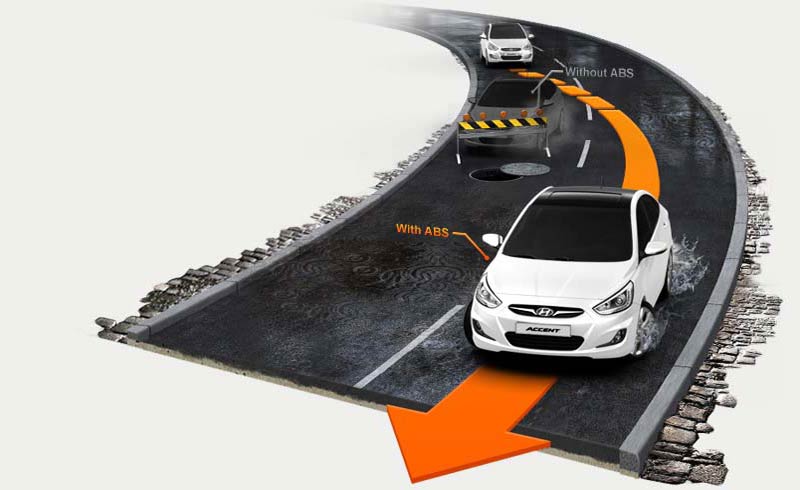By pressing the brake pedal, we slow down the movement of the car. However, if we need to stop instantly, we sharply press the pedal - there is a danger of "skid", i.e. slip of locked wheels, in which the car does not obey the steering wheel. In this situation the ABS system will come to the aid of the driver.
What is ABS (Anti-Locking System)?
This is a series of devices that, when braking the car, regardless of the actions of the driver, prevent the wheels from blocking. Thus, a car with ABS in an emergency stop will not only not “slip” forward with non-rotating wheels, not only will it not lose control, but it will not fly off the roadway.
How does the ABS system work?
Why do you still need to strive to buy a car with ABS? In an emergency, when you instinctively press the brake pedal with force, under any, even the most unfavorable road conditions, the car will not turn around, will not lead you off course. On the contrary, the controllability of the car will remain, which means that you will be able to go around the obstacle, and when braking on a slippery turn, avoid skidding.The operation of the ABS is accompanied by impulse shocks on the brake pedal and the sound of a "ratchet". The serviceability of the system is signaled by a light indicator (with the inscription "ABS") on the instrument panel. The indicator lights up when the ignition is on and goes out 2-3 seconds after the engine is started.
It should be remembered that the braking of a car with ABS should not be repeated and intermittent. The brake pedal must be kept depressed with considerable effort during the braking process - the system itself will provide the shortest braking distance.
On dry roads, ABS can reduce a car's stopping distance by about 20%. compared to the braking distance of cars with locked wheels. On snow, ice, wet pavement, the difference will be much greater. Noticed: the use of ABS helps to increase the life of tires. Experts believe that the presence of ABS in the car creates an illusion of safety for the driver. ABS will prevent the brakes from locking up and allow you to maintain control over directional stability and steering, but it does not guarantee a reduction in stopping distance. In short, no matter how good ABS is in terms of improving the active safety of the car, The driver is still in charge.
Experts believe that the presence of ABS in the car creates an illusion of safety for the driver. ABS will prevent the brakes from locking up and allow you to maintain control over directional stability and steering, but it does not guarantee a reduction in stopping distance. In short, no matter how good ABS is in terms of improving the active safety of the car, The driver is still in charge.
ABS operation and malfunctions
Modern ABS have a fairly high reliability and can work for a long time without fail. ABS electronic units fail extremely rarely, since they are protected by special relays and fuses, and if such a malfunction does occur, then its cause is often associated with violations of rules and recommendations.The most vulnerable in the ABS circuit are wheel sensors located near the rotating parts of the hub or axle shafts. The location of these sensors cannot be called safe: various contaminants or even too much play in the hub bearings can cause sensor malfunctions, which most often become the culprits of ABS malfunctions.
 In addition, the ABS performance is affected by the amount of voltage between the battery terminals. When the voltage drops to 10.5 V and below, the ABS can generally turn off on its own. through the safety electronics. The safety relay may also operate in case of unacceptable fluctuations and surges in the voltage in the car's network.
In addition, the ABS performance is affected by the amount of voltage between the battery terminals. When the voltage drops to 10.5 V and below, the ABS can generally turn off on its own. through the safety electronics. The safety relay may also operate in case of unacceptable fluctuations and surges in the voltage in the car's network.
The fact that the ABS is faulty is indicated by the warning light on the instrument panel. You should not react too nervously to this, the car will not remain without brakes, but when braking it will behave like a car in which there is no ABS.
If the ABS light comes on and off intermittently, then, most likely, some contact in the ABS electrical circuit is acting up. The car should be driven into the inspection ditch, check all the wires and clean the electrical contacts. If the cause of the ABS lamp flashing is not found, then further troubleshooting should be continued at a specialized car service.







